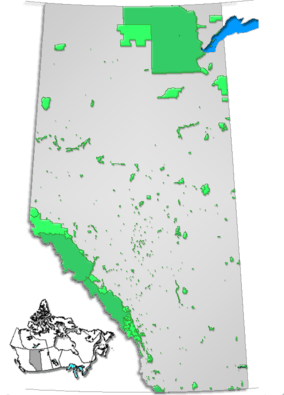Royal Tyrrell Museum of Palaeontology
|
Entrance | |
| Established | September 25, 1985 |
|---|---|
| Location |
Highway 838 Midland Provincial Park Drumheller, Alberta T0J 0Y0 Canada[1] |
| Coordinates | 51°28′46″N 112°47′21″W / 51.479361°N 112.789278°W |
| Type | Palaeontological |
| Visitors | >400,000/year (2009/10)[2] |
| Director | Andrew Neuman[1] |
| Website | www.tyrrellmuseum.com |
The Royal Tyrrell Museum is a Canadian tourist attraction and a centre of palaeontological research[3] noted for its collection of more than 130,000 fossils.[4]
Located 6 kilometres (4 mi) northwest from Drumheller, Alberta and 135 kilometres (84 mi) northeast from Calgary,[5] the museum is situated in the middle of the fossil-bearing strata of the Late Cretaceous Horseshoe Canyon Formation and holds numerous specimens from the Alberta badlands, Dinosaur Provincial Park and the Devil's Coulee Dinosaur Egg Site.[3]
The Royal Tyrrell Museum is operated by Alberta's Ministry of Culture.[6]
History
The Museum is named in honour of Joseph Burr Tyrrell, a geologist who accidentally discovered the first reported dinosaur fossil in the Red Deer River valley in 1884 while searching for coal seams.[7] The carnivorous dinosaur was later named Albertosaurus sarcophagus. The museum opened September 25, 1985 and was given "Royal" status in 1990.
Collections and exhibits
More than 4,400 square metres (47,000 sq ft) of the museum's 11,200 square metres (121,000 sq ft) is dedicated to exhibits[8] in a series of chronological galleries celebrating the 3.9-billion-year-history of life on Earth. One of the most popular is "Dinosaur Hall", with over 40 mounted dinosaur skeletons, including specimens of Tyrannosaurus rex, Albertosaurus, Stegosaurus and Triceratops.[4] Other exhibits include "Lords of the Land", a gallery of some of the most dangerous theropods known from Alberta, "Burgess Shale", a diorama of dozens of creatures from Yoho National Park in British Columbia;[9] "Devonian Reef", a life-size model of a 375-million-year old reef;[10] the newly renovated "Cretaceous Garden", featuring representatives of the plants that lived in prehistoric Alberta,[11] and "Age of Mammals" and "Ice Ages" which cover mammalian life in the Cenozoic. Dioramas painted by Vladimir Krb. Also on display is the "Triassic Giant", a 1,700 square feet (160 m2) specimen of the world's largest known marine reptile. The 21 metres (69 ft) long ichthyosaur Shastasaurus sikanniensis was recovered from the shores of the Sikanni Chief River in northeastern British Columbia by a team led by Elizabeth Nicholls, former curator of Marine Reptiles. This exhibit pays homage to the work of Nicholls, who died in 2004.[12]
A window into the "Preparation Lab" allows visitors to watch technicians as they prepare fossils for research and exhibition.[13] Additional offerings include guided and self-guided tours of the badlands, the hands-on "Science Hall" with interactive stations that introduce palaeontological concepts,[14] simulated fossil digs, fossil casting, school programs and summer camps.
Affiliations
The Museum is affiliated with: CMA, CHIN, and Virtual Museum of Canada.
Images
 Cleaning and preparing a fossil at the museum
Cleaning and preparing a fossil at the museum A detail of The Story of Life, mural sculpted by Canadian artist Lorraine Malach, just inside the museum's entrance
A detail of The Story of Life, mural sculpted by Canadian artist Lorraine Malach, just inside the museum's entrance An exhibit of Gorgosaurus at the museum
An exhibit of Gorgosaurus at the museum Triceratops at the museum
Triceratops at the museum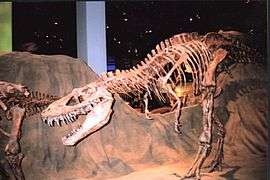 An Albertosaurus and an ankylosaur on display
An Albertosaurus and an ankylosaur on display
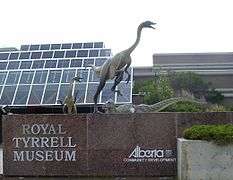 Exterior
Exterior Drumheller Badlands
Drumheller Badlands Chasmosaurus belli found in Dinosaur Provincial Park
Chasmosaurus belli found in Dinosaur Provincial Park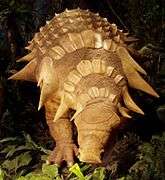
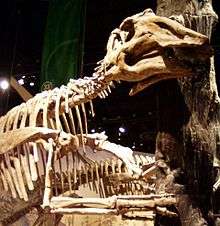
 Tyrannosaurus rex
Tyrannosaurus rex Inside the largest display area
Inside the largest display area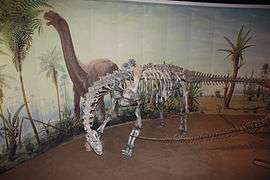 A Camarasaurus on display inside the Museum
A Camarasaurus on display inside the Museum A pack of Albertosauruses
A pack of Albertosauruses- Jurassic section
References
- 1 2 "Contact Us". Royal Tyrrell Museum. Royal Tyrrell Museum Cooperating Society. Retrieved 2008-07-18.
- ↑ "2010/11 Museum Fact Sheet" (PDF). Royal Tyrrell Museum. Royal Tyrrell Museum Cooperating Society. Retrieved 2010-06-19.
- 1 2 Naylor, Bruce G. (1997). "Royal Tyrrell Museum of Palaeontology". In Currie, Philip J.; Padian, Kevin. Encyclopedia of Dinosaurs. Academic Press. p. 646. ISBN 0-12-226810-5.
- 1 2 "Dinosaur Hall". Royal Tyrrell Museum. Royal Tyrrell Museum Cooperating Society. Archived from the original on 2008-05-06. Retrieved 2008-07-18.
- ↑ "Getting to the Museum". Royal Tyrrell Museum. Royal Tyrrell Museum Cooperating Society. Archived from the original on 2008-05-16. Retrieved 2008-07-18.
- ↑ Monty Reid. "Royal Tyrrell Museum of Palaeontology". The Canadian Encyclopedia.
- ↑ Barnes, Michael (1986). Fortunes in the Ground. Erin, Ontario: The Boston Mills Press. p. 198,221. ISBN 091978352X.
- ↑ "Museum Amenities". Royal Tyrrell Museum. Royal Tyrrell Museum Cooperating Society. Archived from the original on 2008-05-16. Retrieved 2008-07-18.
- ↑ "Museum Amenities". Royal Tyrrell Museum. Royal Tyrrell Museum Cooperating Society. Archived from the original on 2008-05-16. Retrieved 2008-07-18.
- ↑ "Devonian Reef". Royal Tyrrell Museum. Royal Tyrrell Museum Cooperating Society. Archived from the original on 2008-05-16. Retrieved 2008-07-18.
- ↑ "Cretaceous Garden". Royal Tyrrell Museum. Royal Tyrrell Museum Cooperating Society. Archived from the original on 2008-05-16. Retrieved 2008-07-18.
- ↑ "Triassic Giant". Royal Tyrrell Museum. Royal Tyrrell Museum Cooperating Society. Archived from the original on 2008-05-14. Retrieved 2008-07-18.
- ↑ "Preparation Lab". Royal Tyrrell Museum. Royal Tyrrell Museum Cooperating Society. Archived from the original on 2008-04-04. Retrieved 2008-07-18.
- ↑ "Nexen Science Hall". Royal Tyrrell Museum. Royal Tyrrell Museum Cooperating Society. Archived from the original on 2008-05-16. Retrieved 2008-07-18.
External links
| Wikimedia Commons has media related to Royal Tyrrell Museum. |
